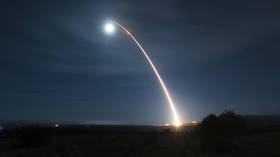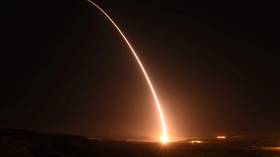US nuclear missile upgrade in jeopardy – media

The US’ Sentinel nuclear missile program, a planned upgrade to the 1970s-era Minuteman intercontinental ballistic missile (ICBM) system, has overspent its budget by over a third in just two years, triggering a mandatory review that could put it at risk of suspension, Bloomberg reported on Thursday.
The cost per new Sentinel missile has increased to as much as $162 million in 2020 dollars from $118 million, according to an estimate sent to Congress seen by the outlet – 37% higher than initially expected. The cost includes the new missile silos and launch control centers planned for the program, which is being developed by military contractor Northrop Grumman.
Assistant US Air Force secretary for acquisition Andrew Hunter told Bloomberg that the price increase “reflects all components of the $96 billion program” and is not the fault of the contractor, claiming the initial cost estimate had simply “failed to capture the massive size and scope of the launch facilities and launch control construction effort,” according to the news outlet.
“The funny thing about once-in-a-century projects [is that] there’s a lot that was not appreciated. It was like we were doing it for the first time,” Hunter explained, adding that the cost increase would only noticeably affect Air Force spending as 2030 approaches.
The Command and Launch nuclear upgrade alone requires over 400 new launch sites to be upgraded from a system that is half a century old, necessitating thousands of miles of fiber-optic communications cable. The rollout must compensate property owners whose land it traverses, as well as the workers needed to install it.
Congress rarely opposes defense spending and even overrode former president Donald Trump’s sole attempt to veto an “unconstitutional” military budget in the last days of his presidency. The ICBM upgrade in particular has extensive support among legislators, who appear to view it as a necessary aspect of competition with Washington’s nuclear-armed rivals.
However, a 1982 law triggered when the cost of major defense programs balloons beyond expected cost requires the Pentagon and Joint Chiefs of Staff to justify the offending program to Congress, explaining in copious detail why it shouldn’t be scrapped or stripped.
In the Sentinel’s case, they will reevaluate program aspects such as the number of missiles ordered, the schedule at which they are deployed, and their manufacturing schedule. The Air Force is reportedly expected to buy about 660 nuclear Sentinel missiles.
Undersecretary of defense for acquisitions William LaPlante promised to “keep our partners in Congress informed and maintain open communications to the greatest extent possible,” insisting the Pentagon was “prepared to fulfill the department’s statutory responsibilities and conduct a robust review” of why the Sentinel program’s costs had somehow run so far over its predictions from September 2020.














